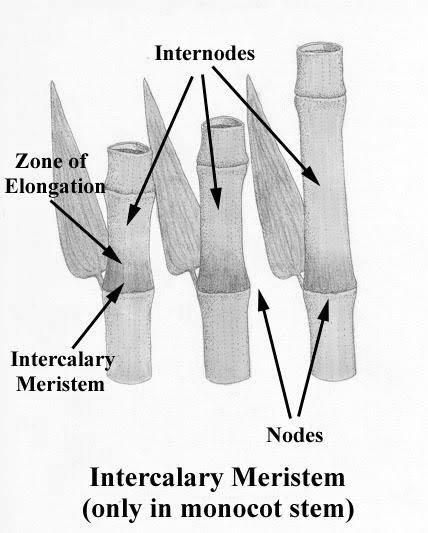
Intercalary meristem is found in
A. Root
B. Stem tip
C. Petiole and internode
D. Latex
Answer
459.3k+ views
Hint: Meristems are present exclusively in plants. The cells in these tissues are known as meristematic cells, which have a high dividing capability. These tissues divide to form all the other organs of the plants.
Complete Answer:
The meristematic tissues that are present at the base of internodes of stem and petioles of leaves are known as Intercalary meristem. The function of these tissues is to promote the growth of the plants by elongating the nodes and internodes present at the leaves and stems. An alternative function of these tissues is in promoting the longitudinal growth of the leaves and stems especially in plants belonging to the grass family. These tissues are present on the base of leaf primordium in monocot plants. The elongation of petioles is a function of the intercalary meristem.

Figure: The position of intercalary meristems
Considering the other given options:
A.Roots consists of meristematic tissue known as the Apical meristem. It helps in the growth and elongation of the roots by enabling their active division. Thus it is not the right option.
B. The meristem present at the stem tip is the Apical meristem and is involved in the growth of the stem. Thus it is not the right option.
D. Latex is a fluid secreted by flowering plants, that has a milky texture. It is an emulsion composed mainly of proteins. It does not contain any meristematic tissues. Thus it is not the right option.
Therefore by considering all the above-given options, the most appropriate option is C. That is, the intercalary meristem is found in petiole and internode.
Note:
Another type of meristematic tissue present in plants is the lateral meristems. These tissues are present on either side of the plant body. These help in the lateral growth of the plants causing an increase in girth.
Complete Answer:
The meristematic tissues that are present at the base of internodes of stem and petioles of leaves are known as Intercalary meristem. The function of these tissues is to promote the growth of the plants by elongating the nodes and internodes present at the leaves and stems. An alternative function of these tissues is in promoting the longitudinal growth of the leaves and stems especially in plants belonging to the grass family. These tissues are present on the base of leaf primordium in monocot plants. The elongation of petioles is a function of the intercalary meristem.

Figure: The position of intercalary meristems
Considering the other given options:
A.Roots consists of meristematic tissue known as the Apical meristem. It helps in the growth and elongation of the roots by enabling their active division. Thus it is not the right option.
B. The meristem present at the stem tip is the Apical meristem and is involved in the growth of the stem. Thus it is not the right option.
D. Latex is a fluid secreted by flowering plants, that has a milky texture. It is an emulsion composed mainly of proteins. It does not contain any meristematic tissues. Thus it is not the right option.
Therefore by considering all the above-given options, the most appropriate option is C. That is, the intercalary meristem is found in petiole and internode.
Note:
Another type of meristematic tissue present in plants is the lateral meristems. These tissues are present on either side of the plant body. These help in the lateral growth of the plants causing an increase in girth.
Recently Updated Pages
Master Class 9 General Knowledge: Engaging Questions & Answers for Success

Master Class 9 English: Engaging Questions & Answers for Success

Master Class 9 Science: Engaging Questions & Answers for Success

Master Class 9 Social Science: Engaging Questions & Answers for Success

Master Class 9 Maths: Engaging Questions & Answers for Success

Class 9 Question and Answer - Your Ultimate Solutions Guide

Trending doubts
Fill the blanks with the suitable prepositions 1 The class 9 english CBSE

The first successful textile mill was established in class 9 social science CBSE

Difference Between Plant Cell and Animal Cell

Given that HCF 306 657 9 find the LCM 306 657 class 9 maths CBSE

The highest mountain peak in India is A Kanchenjunga class 9 social science CBSE

What is the difference between Atleast and Atmost in class 9 maths CBSE




